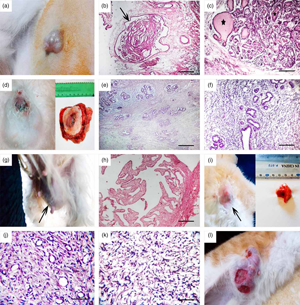Article contents
Pathological and Immunohistochemical Microscopy of Natural Cases of Canine and Feline Neoplastic Mammary Lesions
Published online by Cambridge University Press: 15 June 2021
Abstract

Mammary cancer is the second most common tumor worldwide. Small animal mammary neoplasms provide an outstanding model to study cancer in humans, as tumors in both share a similar environment, histopathologic features, and biological behavior. This study aims to investigate the percentage and microscopy of breast tumors in affected dogs and cats; its relationship to breed, age, and sex; and the immunohistochemical expression of estrogen receptor (ER), progesterone receptor (PR), Ki-67, and cytokeratin 8. Twenty-four females (12 dogs and 12 cats) and one male were examined from February 2018 to February 2020. The highest percentage of mammary neoplasia from the highest to the lowest manifested as tubular carcinoma, leiomyosarcoma, fibroadenoma, and cystic papillary carcinoma. The current study reported the second micropapillary invasive carcinoma in a male cat and the third lipid-rich carcinoma in a female cat. Although tubular carcinoma was the most common mammary neoplasm in cats, leiomyosarcoma was the most common in dogs. The immunohistochemical staining revealed diffuse and intense cytoplasmic immunoreactivity for cytokeratin 8 in lipid-rich carcinomas. However, moderate expression of ER in benign tumors and slight to moderate ER expression in malignant mammary lesions were reported. On the contrary, there was a negative PR expression in benign lesion. It could be concluded that a close relationship between ER expression and nuclear antigen Ki-67 was found.
Keywords
- Type
- Biological Applications
- Information
- Copyright
- Copyright © The Author(s), 2021. Published by Cambridge University Press on behalf of the Microscopy Society of America
References
- 1
- Cited by



